What will we save? The conservation decisions we make today will impact Canada’s wildlife forever
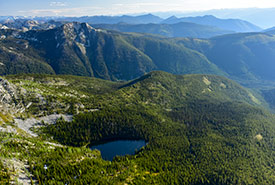
Next Creek alpine lake (Photo by Steve Ogle)
Nature conservation often means making tough decisions. The conservation that does, or doesn’t, happen today will have a big impact on the future of wildlife here in Canada and beyond.
Canada is a large and vast country, and we are one of the few nations that still have large wild areas. Our country holds a disproportional amount of the planet’s remaining lakes, wetlands and intact forests. Perhaps our vast northern hinterland creates the illusion that all of Canada has an abundance of nature. But in addition to being a large country, we are also a diverse country. The habitats and wildlife of Canada’s south are very different than our vast boreal, taiga and Arctic ecosystems in the north. In addition to a very different geography, the southern regions of Canada also share another factor: they are where most Canadians live. Most of our cities, towns and farms are in this region. As a result, it’s the part of Canada where nature has been the most impacted and where conservation efforts are most urgently needed.
But where are the regions in southern Canada that have the most imperiled biodiversity and are also under the greatest threat? And where are the places where we still have the opportunity to protect large and connected natural areas?
A conservation assessment for southern Canada
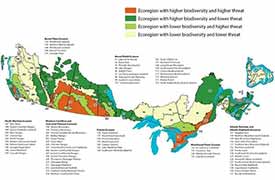
Map of study area showing ecoregions ranked on total biodiversity and total threat score. Click on the map to enlarge.
To help answer these questions, the Nature Conservancy of Canada (NCC) assessed the wildlife, ecosystems and threats to the 77 ecological regions (or ecoregions) found in southern Canada. Ecoregions are units that are defined by distinct ecosystems, vegetation communities and wildlife, and often have similar land uses.
We ranked each of those 77 ecoregions using information about the numbers of endangered species, habitat loss, wildlife corridors and extent of protected lands. The results of our study were published in the journal Biodiversity and Conservation.
Where in southern Canada does nature most need our help?
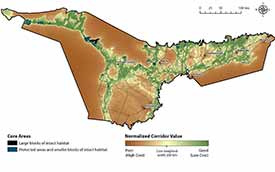
Example of detailed mapping that is available for many ecoregions. Wildlife connectivity for the Manitoulin-Lake Simcoe ecoregion Click on the map to enlarge.
The good news is that there are regions in southern Canada that are important for wildlife and have large areas of natural cover and many protected areas. For example, the Cape Breton Highlands and Eastern Continental Ranges already have a large core of protected areas. Other ecoregions, such as the Appalachians and Western Alberta Upland, still have large areas of natural cover but with fewer protected areas. In some of these regions, we still have the opportunity to protect and connect large, intact areas of natural habitat.
Our study also identified regions in southern Canada that are critically important for wildlife, but are in trouble. At the top of this list, we identified nine "crisis" ecoregions. Over 60 per cent of Canada’s species at risk are found in these ecoregions, which generally have less public land, and few protected areas and remaining natural habitats. They are probably familiar to you because they are where most of our cities, roads and farms can be found. These ecoregions represent less than five per cent of Canada but are where 70 per cent of Canadians live.
These nine regions range from eastern Vancouver Island and BC’s Lower Mainland, through the Prairies and into the fertile farmlands of southern Ontario and the St. Lawrence Valley. In most of these ecoregions, there are only a few scattered protected areas. Here, habitats are continuing to be lost, and both conservation and restoration are urgently needed.
Seeing the big picture in conservation through ecoregions
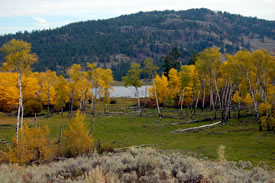
Sage and Sparrow Conservation Area, BC (Photo by NCC)
Of course, wildlife needs our help everywhere. Looking at southern Canada through the lens of ecoregions provides a big-picture perspective. To help fill in the gaps, we have also started to pinpoint key sites for wildlife that are globally imperiled, nationally endangered or found only in Canada. These priority sites highlight many critical places where NCC and other conservation organizations are already working, including the Tall Grass Prairie in Manitoba, BC’s South Okanagan Similkameen and the Avalon Peninsula on the Island of Newfoundland.
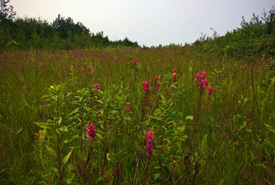
Tall grass prairie, Interlake (Photo by NCC)
Understanding the big picture of southern Canada can help us put our conservation work into context and to better understand how protection of place contributes to regional and national conservation goals. But while big picture maps and studies can help provide general direction on where to work, they cannot reveal what work needs to happen. Local information and input are essential. This is why NCC prepares Natural Area Conservation Plans for the key places where we work. These plans help us to make conservation decisions in a dynamic world and drive conservation opportunities to the most important and urgent properties.
Learning what your role is in conservation
More conservation lands and conservation actions in the most threatened regions in southern Canada are essential to protecting nature in our country. Conserving wildlife and their habitats in these ecoregions will ultimately be determined by the people that live there and their connection to place.
You can find out what ecoregion you live in, learn more about how it ranked in our study and some of the wildlife that lives there by visiting our project website. The conservation assessment includes detailed maps for many regions that highlights hotspots for rare species, wildlife corridors and existing conservation lands. This information is freely available to communities, groups and decision-makers to help put local actions into a broader conservation context so we can all be part of the solution to conserve and restore nature. The Natural Heritage Conservation Program is a way for us all to help support conservation in important regions and sites across our country.
The next 10 years will be our decision decade for nature. In many places, we will choose the wildlife that will be saved, and the wildlife that will be lost. Canada’s current target of protecting 30 per cent of our lands and oceans by 2030 is an opportunity to transform our country by protecting nature and the benefits that nature provides to people. These new protected areas need to include vast areas in our North. But they also need to include wildlife and habitats in our most threatened regions and sites in southern Canada. Our ambitions must be more than just how much we protect, but what we protect. There are thousands of acts of conservation that need to happen across southern Canada in the next decade to protect and restore our wildlife. We all have a role to play.


